Advancements in Performance Optimization of Electrospun Polyethylene Oxide-Based Solid-State Electrolytes for Lithium-Ion Batteries
Abstract
:1. Introduction
2. Enhancement Strategies for Electrospun PEO-Based Solid-State Electrolytes
2.1. Lithium Salts for Electrospun PEO-Based Solid-State Electrolytes
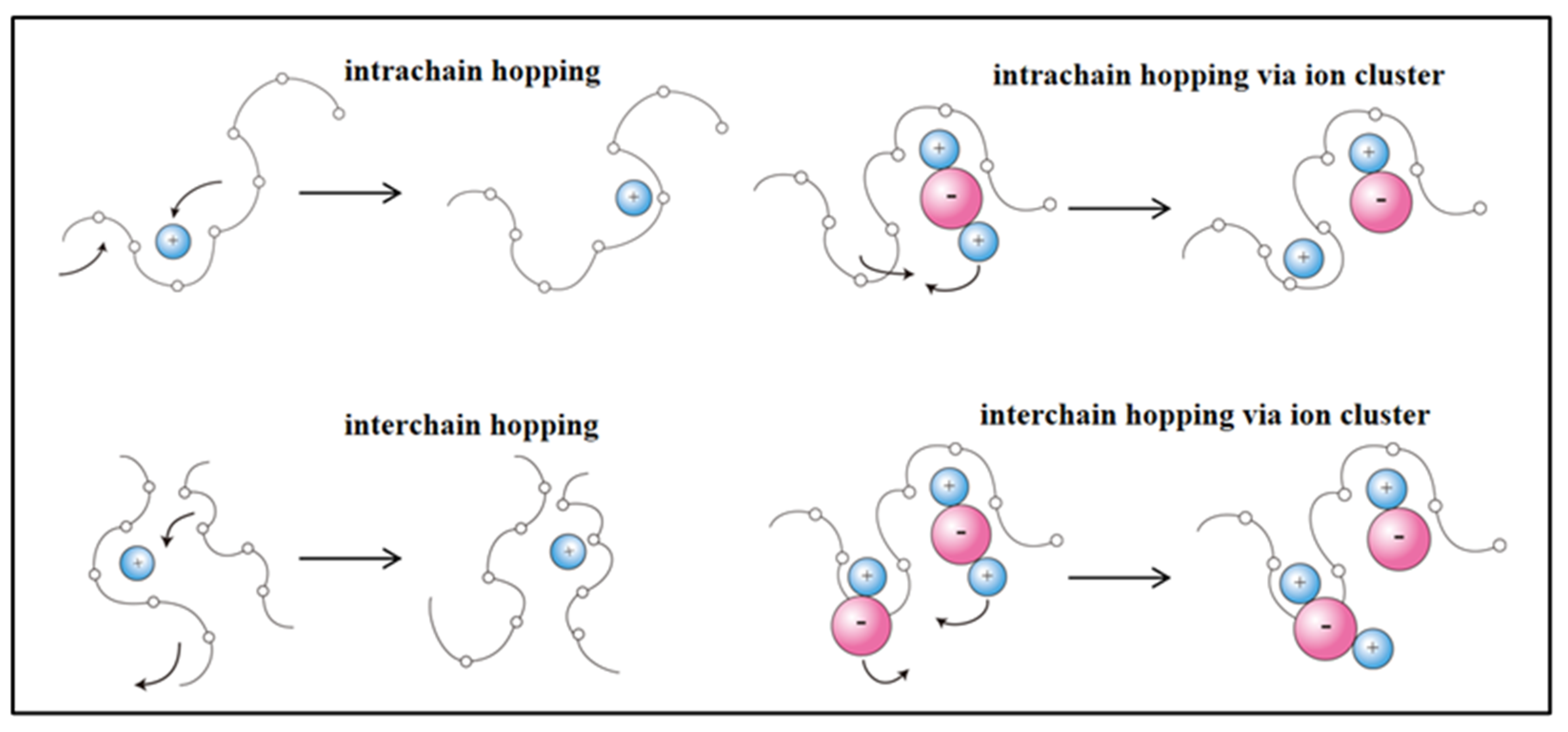
2.2. Additives for Electrospun PEO-Based Solid-State Electrolytes
2.2.1. Plasticizers
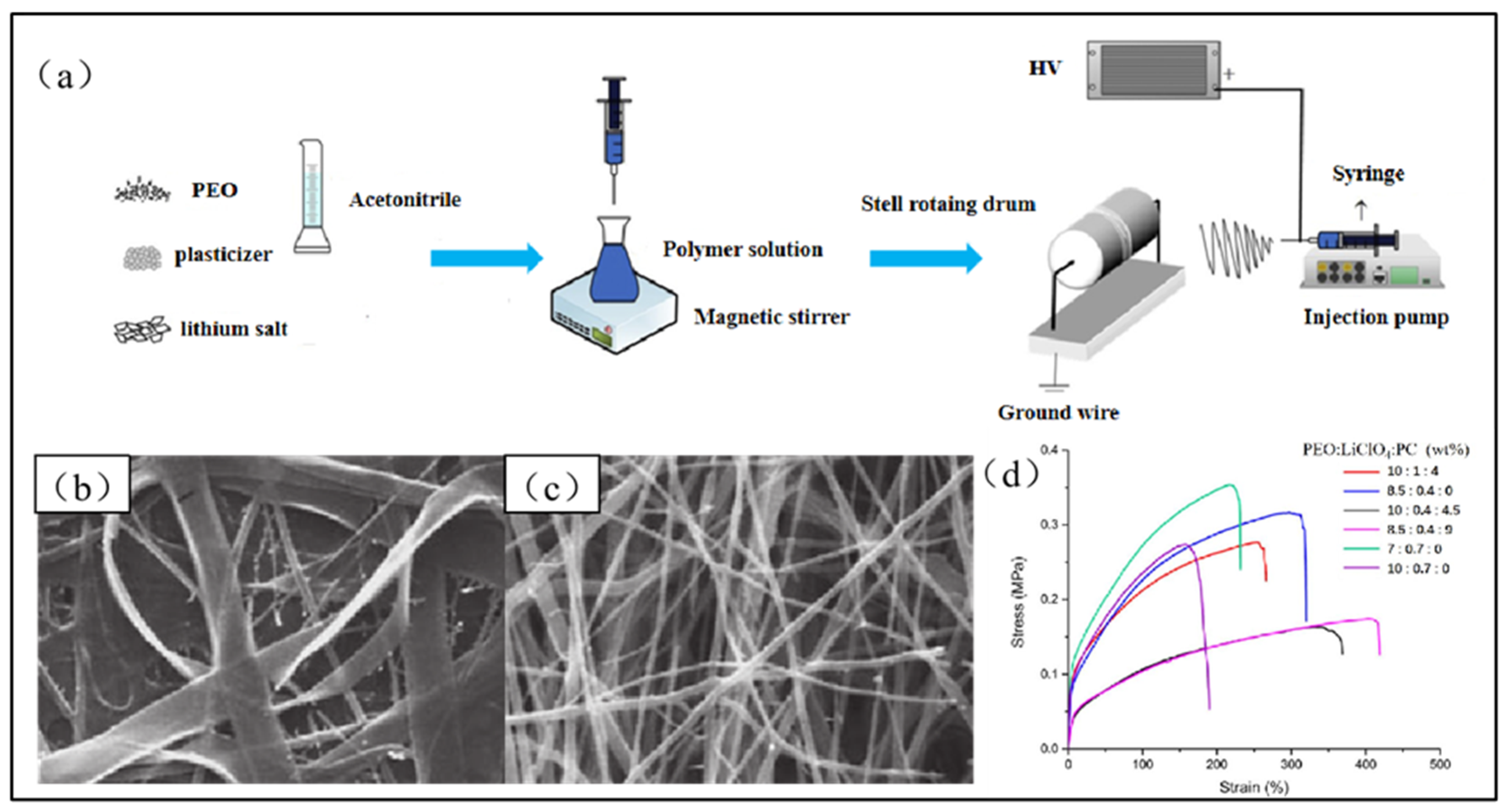
2.2.2. Inorganic Nanofillers
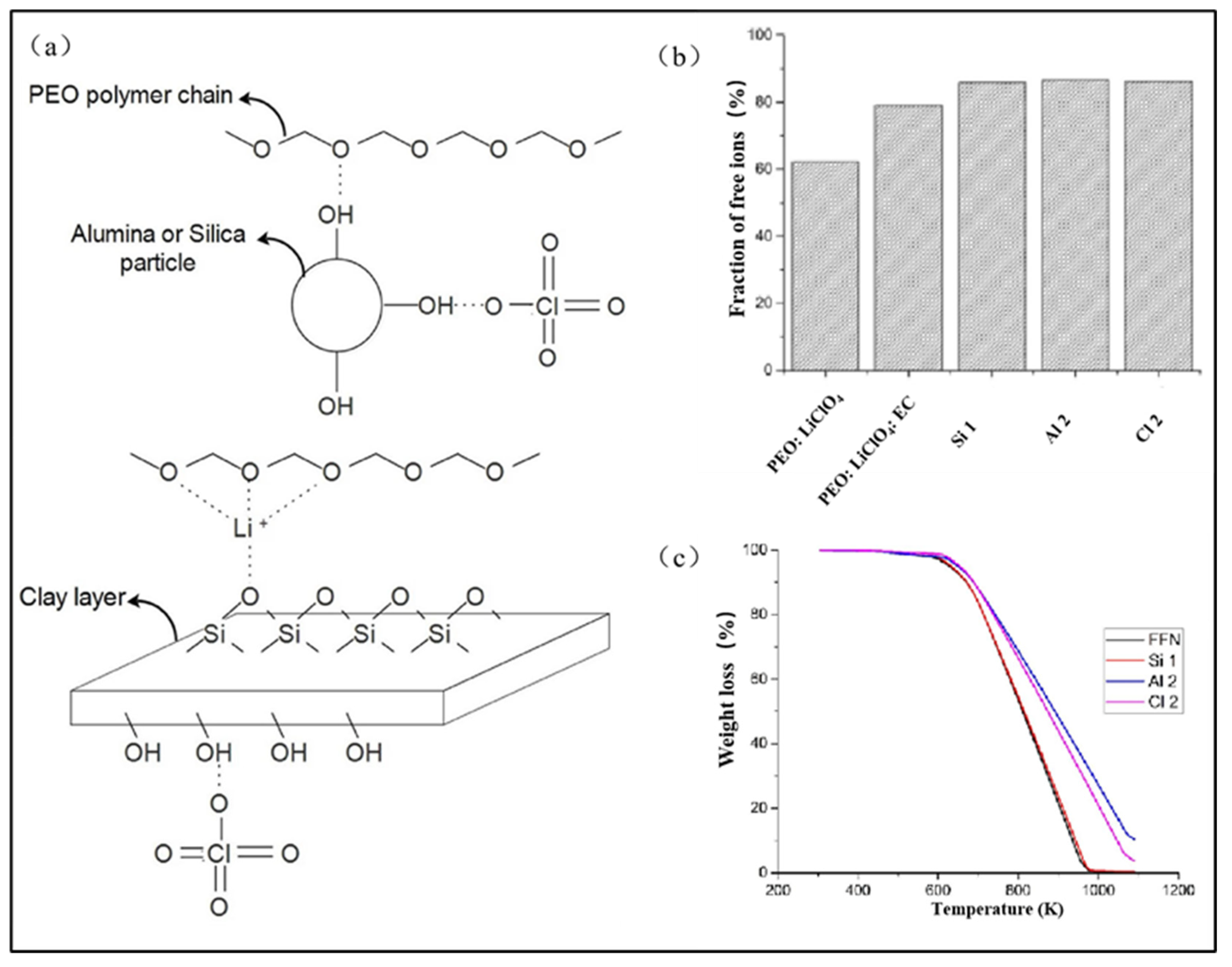
2.2.3. Blending of PEO with Other Polymers
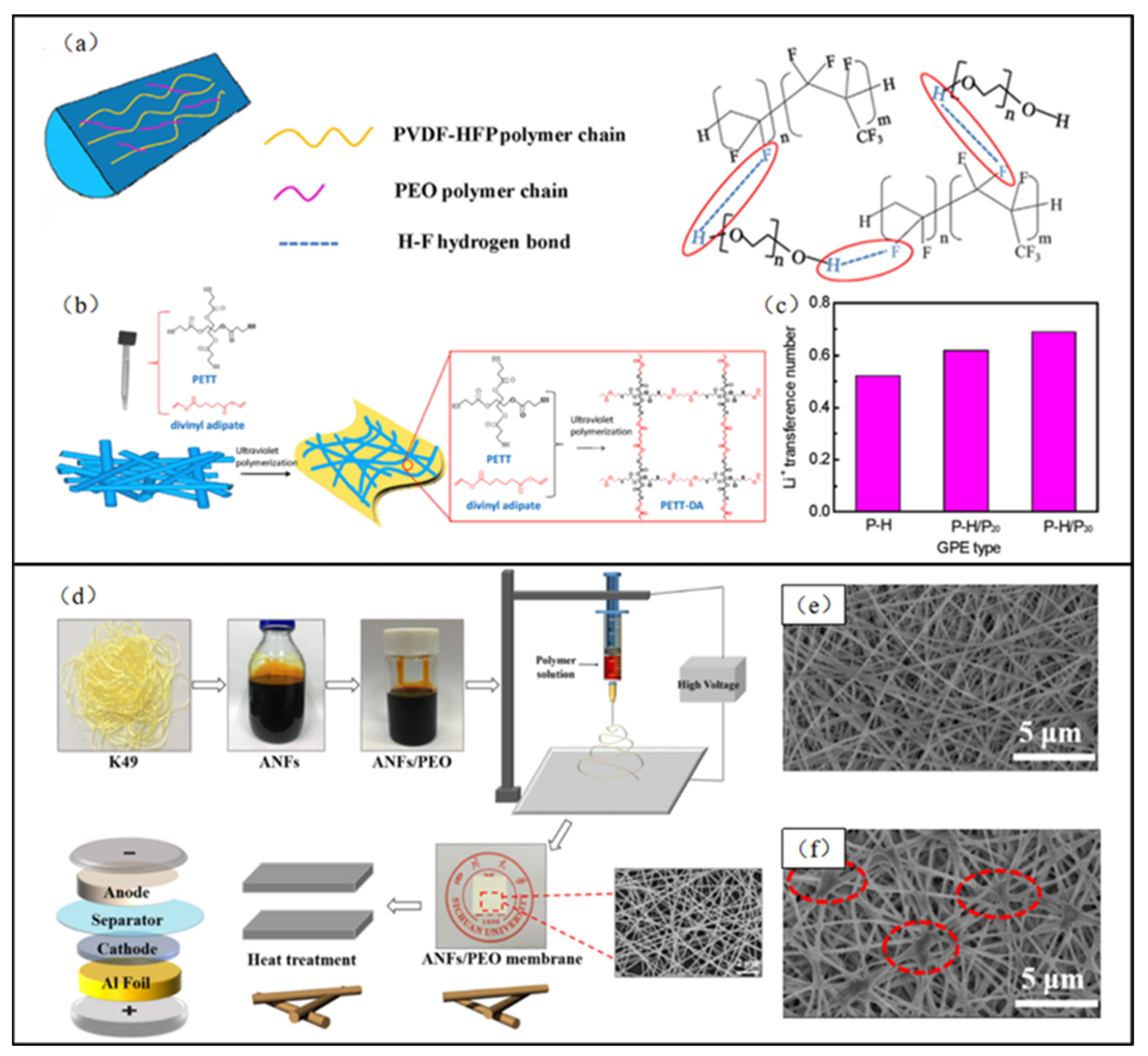
2.3. Modification of PEO Molecular Structure
3. Conclusions and Prospect
Author Contributions
Funding
Institutional Review Board Statement
Data Availability Statement
Conflicts of Interest
References
- Lu, W.; Yuan, Z.; Zhao, Y.; Zhang, H.; Zhang, H.; Li, X. Porous membranes in secondary battery technologies. Chem. Soc. Rev. 2017, 46, 2199–2236. [Google Scholar] [CrossRef] [PubMed]
- Hsu, C.-Y.; Liu, R.-J.; Hsu, C.-H.; Kuo, P.-L. High thermal and electrochemical stability of PVDF-graft-PAN copolymer hybrid PEO membrane for safety reinforced lithium-ion battery. RSC Adv. 2016, 6, 18082–18088. [Google Scholar] [CrossRef]
- Zhou, G.; Li, F.; Cheng, H.-M. Progress in flexible lithium batteries and future prospects. Energy Environ. Sci. 2014, 7, 1307–1338. [Google Scholar] [CrossRef]
- Baek, S.-W.; Honma, I.; Kim, J.; Rangappa, D. Solidified inorganic-organic hybrid electrolyte for all solid state flexible lithium battery. J. Power Sources 2017, 343, 22–29. [Google Scholar] [CrossRef]
- Li, Y.-H.; Wu, X.-L.; Kim, J.-H.; Xin, S.; Su, J.; Yan, Y.; Lee, J.-S.; Guo, Y.-G. A novel polymer electrolyte with improved high-temperature-tolerance up to 170 °C for high-temperature lithium-ion batteries. J. Power Sources 2013, 244, 234–239. [Google Scholar] [CrossRef]
- Scrosati, B.; Hassoun, J.; Sun, Y.-K. Lithium-ion batteries. A look into the future. Energy Environ. Environ. Sci. 2011, 4, 3287–3295. [Google Scholar] [CrossRef]
- Goodenough, J.B.; Park, K.S. The Li-ion rechargeable battery: A perspective. J. Am. Chem. Soc. 2013, 135, 1167–1176. [Google Scholar] [CrossRef]
- Liang, J.; Luo, J.; Sun, Q.; Yang, X.; Li, R.; Sun, X. Recent progress on solid-state hybrid electrolytes for solid-state lithium batteries. Energy Storage Mater. 2019, 21, 308–334. [Google Scholar] [CrossRef]
- Kim, J.G.; Son, B.; Mukherjee, S.; Schuppert, N.; Bates, A.; Kwon, O.; Choi, M.J.; Chung, H.Y.; Park, S. A review of lithium and non-lithium based solid state batteries. J. Power Sources 2015, 282, 299–322. [Google Scholar] [CrossRef]
- Wu, Y.; Li, Y.; Wang, Y.; Liu, Q.; Chen, Q.; Chen, M. Advances and prospects of PVDF based polymer electrolytes. J. Energy Chem. 2022, 64, 62–84. [Google Scholar] [CrossRef]
- Yuriar-Arredondo, K.; Armstrong, M.R.; Shan, B.; Zeng, W.; Xu, W.; Jiang, H.; Mu, B. Nanofiber-based Matrimid organogel membranes for battery separator. J. Membr. Sci. 2018, 546, 158–164. [Google Scholar] [CrossRef]
- Zhou, W.; Wang, Z.; Pu, Y.; Li, Y.; Xin, S.; Li, X.; Chen, J.; Goodenough, J.B. Double-Layer Polymer Electrolyte for High-Voltage All-Solid-State Rechargeable Batteries. Adv. Mater. 2019, 31, 1805574. [Google Scholar] [CrossRef]
- Li, D.; Chen, L.; Wang, T.; Fan, L.Z. 3D Fiber-Network-Reinforced Bicontinuous Composite Solid Electrolyte for Dendrite-free Lithium Metal Batteries. ACS Appl. Mater. Interfaces 2018, 10, 7069–7078. [Google Scholar] [CrossRef] [PubMed]
- Rathika, R.; Suthanthiraraj, S.A. Ionic Interactions and Dielectric Relaxation of PEO/PVDF-Mg[(CF3SO2)2N2)] Blend Electrolytes for Magnesium Ion Rechargeable Batteries. Macromol. Res. 2016, 24, 422–428. [Google Scholar] [CrossRef]
- Hu, J.; Wang, W.; Zhou, B.; Feng, Y.; Xie, X.; Xue, Z. Poly(ethylene oxide)-based composite polymer electrolytes embedding with ionic bond modified nanoparticles for all-solid-state lithium-ion battery. J. Membr. Sci. 2019, 575, 200–208. [Google Scholar] [CrossRef]
- Tarascon, J.-M.; Armand, M. Issues and challenges facing rechargeable lithium batteries. Nature 2001, 414, 359–367. [Google Scholar] [CrossRef]
- Masoud, E.M. Citrated porous gel copolymer electrolyte composite for lithium ion batteries application: An investigation of ionic conduction in an optimized crystalline and porous structure. J. Alloys Compd. 2015, 651, 157–163. [Google Scholar] [CrossRef]
- Ye, Q.; Liang, H.; Wang, S.; Cui, C.; Zeng, C.; Zhai, T.; Li, H. Fabricating a PVDF skin for PEO-based SPE to stabilize the interface both at cathode and anode for Li-ion batteries. J. Energy Chem. 2022, 70, 356–362. [Google Scholar] [CrossRef]
- Song, J.; Wang, Y.; Wan, C.C. Review of gel-type polymer electrolytes for lithium-ion batteries. J. Power Sources 1999, 77, 183–197. [Google Scholar] [CrossRef]
- Dias, F.B.; Plomp, L.; Veldhuis, J.B. Trends in polymer electrolytes for secondary lithium batteries. J. Power Sources 2000, 88, 169–191. [Google Scholar] [CrossRef]
- Zhu, Y.; Hu, A.; Tang, Q.; Zhang, S.; Deng, W.; Li, Y.; Liu, Z.; Fan, B.; Xiao, K.; Liu, J.; et al. Compact-Nanobox Engineering of Transition Metal Oxides with Enhanced Initial Coulombic Efficiency for Lithium-Ion Battery Anodes. ACS Appl. Mater. Interfaces 2018, 10, 8955–8964. [Google Scholar] [CrossRef]
- Zheng, C.; Li, L.; Wang, K.; Wang, C.; Zhang, J.; Xia, Y.; Huang, H.; Liang, C.; Gan, Y.; He, X.; et al. Interfacial Reactions in Inorganic All-Solid-State Lithium Batteries. Batter. Supercaps 2020, 4, 8–38. [Google Scholar] [CrossRef]
- Fenton, D. Complexes of Alkali Metal Ions with Poly (etylene oxide). Polymer 1973, 14, 589. [Google Scholar] [CrossRef]
- Shi, C.; Yu, M. Flexible solid-state lithium-sulfur batteries based on structural designs. Energy Storage Mater. 2023, 57, 429–459. [Google Scholar] [CrossRef]
- Cheng, S.; Smith, D.M.; Li, C.Y. How Does Nanoscale Crystalline Structure Affect Ion Transport in Solid Polymer Electrolytes? Macromolecules 2014, 47, 3978–3986. [Google Scholar] [CrossRef]
- Tarascon, J.-M.; Gozdz, A.; Schmutz, C.; Shokoohi, F.; Warren, P. Performance of Bellcore’s plastic rechargeable Li-ion batteries. Solid State Ion. 1996, 86, 49–54. [Google Scholar] [CrossRef]
- Hooper, A.; North, J.M. The fabrication and performance of all solid state polymer-based rechargeable lithium cells. Solid State Ion. 1983, 9, 1161–1166. [Google Scholar] [CrossRef]
- Bannister, D.; Davies, G.; Ward, I.; McIntyre, J. Ionic conductivities for poly (ethylene oxide) complexes with lithium salts of monobasic and dibasic acids and blends of poly (ethylene oxide) with lithium salts of anionic polymers. Polymer 1984, 25, 1291–1296. [Google Scholar] [CrossRef]
- Bates, J.; Dudney, N.; Gruzalski, G.; Zuhr, R.; Choudhury, A.; Luck, C.; Robertson, J. Electrical properties of amorphous lithium electrolyte thin films. Solid State Ion. 1992, 53, 647–654. [Google Scholar] [CrossRef]
- Clericuzio, M.; Parker Jr, W.; Soprani, M.; Andrei, M. Ionic diffusivity and conductivity of plasticized polymer electrolytes: PMFG-NMR and complex impedance studies. Solid State Ion. 1995, 82, 179–192. [Google Scholar] [CrossRef]
- Michot, T.; Nishimoto, A.; Watanabe, M. Electrochemical properties of polymer gel electrolytes based on poly (vinylidene fluoride) copolymer and homopolymer. Electrochim. Acta 2000, 45, 1347–1360. [Google Scholar] [CrossRef]
- Quartarone, E.; Mustarelli, P.; Magistris, A. PEO-based composite polymer electrolytes. Solid State Ion. 1998, 110, 1–14. [Google Scholar] [CrossRef]
- Zhang, X.; Ji, L.; Toprakci, O.; Liang, Y.; Alcoutlabi, M. Electrospun nanofiber-based anodes, cathodes, and separators for advanced lithium-ion batteries. Polym. Rev. 2011, 51, 239–264. [Google Scholar] [CrossRef]
- Ogasawara, T.; Débart, A.; Holzapfel, M.; Novák, P.; Bruce, P.G. Rechargeable Li2O2 electrode for lithium batteries. J. Am. Chem. Soc. 2006, 128, 1390–1393. [Google Scholar] [CrossRef]
- Ji, X.; Nazar, L.F. Advances in Li–S batteries. J. Mater. Chem. 2010, 20, 9821–9826. [Google Scholar] [CrossRef]
- Huang, W.; Pan, Q.; Qi, H.; Li, X.; Tu, Y.; Li, C.Y. Poly (butylene terephthalate)-b-poly (ethylene oxide) alternating multiblock copolymers: Synthesis and application in solid polymer electrolytes. Polymer 2017, 128, 188–199. [Google Scholar] [CrossRef]
- Chen, Y.; Shi, Y.; Liang, Y.; Dong, H.; Hao, F.; Wang, A.; Zhu, Y.; Cui, X.; Yao, Y. Hyperbranched PEO-based hyperstar solid polymer electrolytes with simultaneous improvement of ion transport and mechanical strength. ACS Appl. Energy Mater. 2019, 2, 1608–1615. [Google Scholar] [CrossRef]
- Liu, X.; Liang, Q.; Chen, L.; Tang, J.; Liu, J.; Tang, M.; Wang, Z. PEO-Based Solid-State Electrolytes Reinforced by High Strength, Interconnected MOF Networks. ACS Appl. Energy Mater. 2023, 6, 4881–4891. [Google Scholar] [CrossRef]
- Liu, S.; Liu, W.; Ba, D.; Zhao, Y.; Ye, Y.; Li, Y.; Liu, J. Filler-integrated composite polymer electrolyte for solid-state lithium batteries. Adv. Mater. 2023, 35, 2110423. [Google Scholar] [CrossRef]
- Keller, M.; Appetecchi, G.B.; Kim, G.-T.; Sharova, V.; Schneider, M.; Schuhmacher, J.; Roters, A.; Passerini, S. Electrochemical performance of a solvent-free hybrid ceramic-polymer electrolyte based on Li7La3Zr2O12 in P(EO) 15 LiTFSI. J. Power Sources 2017, 353, 287–297. [Google Scholar] [CrossRef]
- Chen, R.J.; Zhang, Y.B.; Liu, T.; Xu, B.Q.; Lin, Y.H.; Nan, C.W.; Shen, Y. Addressing the Interface Issues in All-Solid-State Bulk-Type Lithium Ion Battery via an All-Composite Approach. ACS Appl. Mater. Interfaces 2017, 9, 9654–9661. [Google Scholar] [CrossRef]
- Anton, F. Process and Apparatus for Preparing Artificial Threads. US1975504A, 2 October 1934. [Google Scholar]
- Taylor, G.I. Disintegration of water drops in an electric field. Proceedings of the Royal Society of London. Ser. A Math. Phys. Sci. 1964, 280, 383–397. [Google Scholar]
- Doshi, J.; Reneker, D.H. Electrospinning process and applications of electrospun fibers. J. Electrost. 1995, 35, 151–160. [Google Scholar] [CrossRef]
- Banitaba, S.N.; Semnani, D.; Karimi, M.; Heydari-Soureshjani, E.; Rezaei, B.; Ensafi, A.A. A comparative analysis on the morphology and electrochemical performances of solution-casted and electrospun PEO-based electrolytes: The effect of fiber diameter and surface density. Electrochim. Acta 2021, 368, 137339. [Google Scholar] [CrossRef]
- Robert Ilango, P.; Peng, S. Electrospinning techniques for Li, Na and K-ion batteries. Curr. Opin. Electrochem. 2019, 18, 106–112. [Google Scholar] [CrossRef]
- Kim, H.; Jeong, G.; Kim, Y.U.; Kim, J.H.; Park, C.M.; Sohn, H.J. Metallic anodes for next generation secondary batteries. Chem. Soc. Rev. 2013, 42, 9011–9034. [Google Scholar] [CrossRef]
- Aurbach, D.; Zinigrad, E.; Cohen, Y.; Teller, H. A short review of failure mechanisms of lithium metal and lithiated graphite anodes in liquid electrolyte solutions. Solid State Ion. 2002, 148, 405–416. [Google Scholar] [CrossRef]
- Xu, K. Electrolytes and interphases in Li-ion batteries and beyond. Chem. Rev. 2014, 114, 11503–11618. [Google Scholar] [CrossRef]
- Zhou, D.; Liu, R.; He, Y.-B.; Li, F.; Liu, M.; Li, B.; Yang, Q.-H.; Cai, Q.; Kang, F. SiO2Hollow Nanosphere-Based Composite Solid Electrolyte for Lithium Metal Batteries to Suppress Lithium Dendrite Growth and Enhance Cycle Life. Adv. Energy Mater. 2016, 6, 1502214. [Google Scholar] [CrossRef]
- Gong, W.; Zhang, Z.; Wei, S.; Ruan, S.; Shen, C.; Turng, L.-S. Thermosensitive polyacrylonitrile/polyethylene oxide/polyacrylonitrile membrane separators for prompt and safer thermal lithium-ion battery shutdown. J. Electrochem. Soc. 2020, 167, 020509. [Google Scholar] [CrossRef]
- Feng, S.; Shi, D.; Liu, F.; Zheng, L.; Nie, J.; Feng, W.; Huang, X.; Armand, M.; Zhou, Z. Single lithium-ion conducting polymer electrolytes based on poly[(4-styrenesulfonyl)(trifluoromethanesulfonyl)imide] anions. Electrochim. Acta 2013, 93, 254–263. [Google Scholar] [CrossRef]
- Fullerton-Shirey, S.K.; Maranas, J.K. Effect of LiClO4 on the structure and mobility of PEO-based solid polymer electrolytes. Macromolecules 2009, 42, 2142–2156. [Google Scholar] [CrossRef]
- Marzantowicz, M.; Krok, F.; Dygas, J.R.; Florjańczyk, Z.; Zygadło-Monikowska, E. The influence of phase segregation on properties of semicrystalline PEO:LiTFSI electrolytes. Solid State Ion. 2008, 179, 1670–1678. [Google Scholar] [CrossRef]
- Wang, S. Development of Solid Polymer Electrolytes of Polyurethane and Polyether-Modified Polysiloxane Blends with Lithium Salts; University of Akron: Akron, ON, USA, 2007. [Google Scholar]
- Haider, A.; Haider, S.; Kang, I.-K. A comprehensive review summarizing the effect of electrospinning parameters and potential applications of nanofibers in biomedical and biotechnology. Arab. J. Chem. 2018, 11, 1165–1188. [Google Scholar] [CrossRef]
- Yalcinkaya, F.; Yalcinkaya, B.; Jirsak, O. Influence of Salts on Electrospinning of Aqueous and Nonaqueous Polymer Solutions. J. Nanomater. 2015, 2015, 134251. [Google Scholar] [CrossRef]
- Vorrey, S.; Teeters, D. Study of the ion conduction of polymer electrolytes confined in micro and nanopores. Electrochim. Acta 2003, 48, 2137–2141. [Google Scholar] [CrossRef]
- Xue, Z.; He, D.; Xie, X. Poly(ethylene oxide)-based electrolytes for lithium-ion batteries. J. Mater. Chem. A 2015, 3, 19218–19253. [Google Scholar] [CrossRef]
- Banitaba, S.N.; Semnani, D.; Fakhrali, A.; Ebadi, S.V.; Heydari-Soureshjani, E.; Rezaei, B.; Ensafi, A.A. Electrospun PEO nanofibrous membrane enable by LiCl, LiClO4, and LiTFSI salts: A versatile solvent-free electrolyte for lithium-ion battery application. Ionics 2020, 26, 3249–3260. [Google Scholar] [CrossRef]
- McLin, M.; Angell, C. Frequency-dependent conductivity, relaxation times, and the conductivity/viscosity coupling problem, in polymer-electrolyte solutions: LiClO4 and NaCF3SO3 in PPO 4000. Solid State Ion. 1992, 53, 1027–1036. [Google Scholar] [CrossRef]
- Chang, C.-W.; Lai, W.-C. A strategy for preparing solid polymer electrolytes via the electrospinning process. J. Taiwan Inst. Chem. Eng. 2020, 116, 279–285. [Google Scholar] [CrossRef]
- Walke, P.; Freitag, K.M.; Kirchhain, H.; Kaiser, M.; van Wüllen, L.; Nilges, T. Electrospun Li(TFSI)@Polyethylene Oxide Membranes as Solid Electrolytes. Z. Für Anorg. Und Allg. Chem. 2018, 644, 1863–1874. [Google Scholar] [CrossRef]
- Bandara, L.; Dissanayake, M.; Mellander, B.-E. Ionic conductivity of plasticized (PEO)-LiCF3SO3 electrolytes. Electrochim. Acta 1998, 43, 1447–1451. [Google Scholar] [CrossRef]
- Kim, Y.-T.; Smotkin, E.S. The effect of plasticizers on transport and electrochemical properties of PEO-based electrolytes for lithium rechargeable batteries. Solid State Ion. 2002, 149, 29–37. [Google Scholar] [CrossRef]
- Nicotera, I.; Ranieri, G.A.; Terenzi, M.; Chadwick, A.V.; Webster, M.I. A study of stability of plasticized PEO electrolytes. Solid State Ion. 2002, 146, 143–150. [Google Scholar] [CrossRef]
- Qian, X.; Gu, N.; Cheng, Z.; Yang, X.; Wang, E.; Dong, S. Plasticizer effect on the ionic conductivity of PEO-based polymer electrolyte. Mater. Chem. Phys. 2002, 74, 98–103. [Google Scholar] [CrossRef]
- Fergus, J.W. Ceramic and polymeric solid electrolytes for lithium-ion batteries. J. Power Sources 2010, 195, 4554–4569. [Google Scholar] [CrossRef]
- Srivastava, S.; Schaefer, J.L.; Yang, Z.; Tu, Z.; Archer, L.A. 25th anniversary article: Polymer-particle composites: Phase stability and applications in electrochemical energy storage. Adv. Mater. 2014, 26, 201–234. [Google Scholar] [CrossRef] [PubMed]
- Krawiec, W.; Scanlon, L., Jr.; Fellner, J.; Vaia, R.; Vasudevan, S.; Giannelis, E. Polymer nanocomposites: A new strategy for synthesizing solid electrolytes for rechargeable lithium batteries. J. Power Sources 1995, 54, 310–315. [Google Scholar] [CrossRef]
- Jacob, M.; Prabaharan, S.; Radhakrishna, S. Effect of PEO addition on the electrolytic and thermal properties of PVDF-LiClO4 polymer electrolytes. Solid State Ion. 1997, 104, 267–276. [Google Scholar] [CrossRef]
- Michael, M.; Jacob, M.; Prabaharan, S.; Radhakrishna, S. Enhanced lithium ion transport in PEO-based solid polymer electrolytes employing a novel class of plasticizers. Solid State Ion. 1997, 98, 167–174. [Google Scholar] [CrossRef]
- Walker, C.W.; Salomon, M. Improvement of ionic conductivity in plasticized PEO-based solid polymer electrolytes. J. Electrochem. Soc. 1993, 140, 3409. [Google Scholar] [CrossRef]
- Banitaba, S.N.; Semnani, D.; Rezaei, B.; Ensafi, A.A. Morphology and electrochemical and mechanical properties of polyethylene-oxide-based nanofibrous electrolytes applicable in lithium ion batteries. Polym. Int. 2019, 68, 746–754. [Google Scholar] [CrossRef]
- Li, T.; Balbuena, P.B. Theoretical studies of lithium perchlorate in ethylene carbonate, propylene carbonate, and their mixtures. J. Electrochem. Soc. 1999, 146, 3613. [Google Scholar] [CrossRef]
- Banitaba, S.N.; Semnani, D.; Heydari-Soureshjani, E.; Rezaei, B.; Ensafi, A.A. The effect of concentration and ratio of ethylene carbonate and propylene carbonate plasticizers on characteristics of the electrospun PEO-based electrolytes applicable in lithium-ion batteries. Solid State Ion. 2020, 347, 115252. [Google Scholar] [CrossRef]
- Voigt, N.; van Wüllen, L. The effect of plastic-crystalline succinonitrile on the electrolyte system PEO:LiBF4: Insights from solid state NMR. Solid State Ion. 2014, 260, 65–75. [Google Scholar] [CrossRef]
- Freitag, K.M.; Kirchhain, H.; Wullen, L.V.; Nilges, T. Enhancement of Li Ion Conductivity by Electrospun Polymer Fibers and Direct Fabrication of Solvent-Free Separator Membranes for Li Ion Batteries. Inorg. Chem. 2017, 56, 2100–2107. [Google Scholar] [CrossRef]
- Liu, W.; Lin, D.; Sun, J.; Zhou, G.; Cui, Y. Improved Lithium Ionic Conductivity in Composite Polymer Electrolytes with Oxide-Ion Conducting Nanowires. ACS Nano 2016, 10, 11407–11413. [Google Scholar] [CrossRef]
- Zhang, S.S. A review on electrolyte additives for lithium-ion batteries. J. Power Sources 2006, 162, 1379–1394. [Google Scholar] [CrossRef]
- Meziane, R.; Bonnet, J.-P.; Courty, M.; Djellab, K.; Armand, M. Single-ion polymer electrolytes based on a delocalized polyanion for lithium batteries. Electrochim. Acta 2011, 57, 14–19. [Google Scholar] [CrossRef]
- Wimalaweera, K.; Seneviratne, V.; Dissanayake, M. Effect of Al2O3 ceramic filler on thermal and transport properties of poly (ethylene oxide)-lithium perchlorate solid polymer electrolyte. Procedia Eng. 2017, 215, 109–114. [Google Scholar] [CrossRef]
- Liu, W.; Liu, N.; Sun, J.; Hsu, P.C.; Li, Y.; Lee, H.W.; Cui, Y. Ionic conductivity enhancement of polymer electrolytes with ceramic nanowire fillers. Nano Lett. 2015, 15, 2740–2745. [Google Scholar] [CrossRef]
- Li, Z.; Sha, W.X.; Guo, X. Three-Dimensional Garnet Framework-Reinforced Solid Composite Electrolytes with High Lithium-Ion Conductivity and Excellent Stability. ACS Appl. Mater. Interfaces 2019, 11, 26920–26927. [Google Scholar] [CrossRef] [PubMed]
- Zaccaria, M.; Gualandi, C.; Fabiani, D.; Focarete, M.L.; Croce, F. Effect of Oxide Nanoparticles on Thermal and Mechanical Properties of Electrospun Separators for Lithium-Ion Batteries. J. Nanomater. 2012, 2012, 1–8. [Google Scholar] [CrossRef]
- Banitaba, S.N.; Semnani, D.; Heydari-Soureshjani, E.; Rezaei, B.; Ensafi, A.A. Electrospun polyethylene oxide-based membranes incorporated with silicon dioxide, aluminum oxide and clay nanoparticles as flexible solvent-free electrolytes for lithium-ion batteries. Jom 2019, 71, 4537–4546. [Google Scholar] [CrossRef]
- Drew, C.; Wang, X.; Samuelson, L.A.; Kumar, J. The effect of viscosity and filler on electrospun fiber morphology. J. Macromol. Sci. Part A 2003, 40, 1415–1422. [Google Scholar] [CrossRef]
- Pant, H.R.; Bajgai, M.P.; Nam, K.T.; Seo, Y.A.; Pandeya, D.R.; Hong, S.T.; Kim, H.Y. Electrospun nylon-6 spider-net like nanofiber mat containing TiO(2) nanoparticles: A multifunctional nanocomposite textile material. J. Hazard. Mater. 2011, 185, 124–130. [Google Scholar] [CrossRef] [PubMed]
- Banitaba, S.N.; Semnani, D.; Heydari-Soureshjani, E.; Rezaei, B.; Ensafi, A.A. Effect of titanium dioxide and zinc oxide fillers on morphology, electrochemical and mechanical properties of the PEO-based nanofibers, applicable as an electrolyte for lithium-ion batteries. Mater. Res. Express 2019, 6, 0850d0856. [Google Scholar] [CrossRef]
- Abdollahi, S.; Sadadi, H.; Ehsani, M.; Aram, E. Highly efficient polymer electrolyte based on electrospun PEO/PAN/single-layered graphene oxide. Ionics 2021, 27, 3477–3487. [Google Scholar] [CrossRef]
- Banitaba, S.N.; Semnani, D.; Heydari-Soureshjani, E.; Rezaei, B.; Ensafi, A.A. Nanofibrous poly(ethylene oxide)-based structures incorporated with multi-walled carbon nanotube and graphene oxide as all-solid-state electrolytes for lithium ion batteries. Polym. Int. 2019, 68, 1787–1794. [Google Scholar] [CrossRef]
- Banitaba, S.N.; Semnani, D.; Heydari-Soureshjani, E.; Rezaei, B.; Ensafi, A.A. Electrospun core-shell nanofibers based on polyethylene oxide reinforced by multiwalled carbon nanotube and silicon dioxide nanofillers: A novel and effective solvent-free electrolyte for lithium ion batteries. Int. J. Energy Res. 2020, 44, 7000–7014. [Google Scholar] [CrossRef]
- Gan, H.; Li, S.; Zhang, Y.; Wang, J.; Xue, Z. Electrospun Composite Polymer Electrolyte Membrane Enabled with Silica-Coated Silver Nanowires. Eur. J. Inorg. Chem. 2021, 2021, 4639–4646. [Google Scholar] [CrossRef]
- Zhu, L.; Zhu, P.; Fang, Q.; Jing, M.; Shen, X.; Yang, L. A novel solid PEO/LLTO-nanowires polymer composite electrolyte for solid-state lithium-ion battery. Electrochimica Acta 2018, 292, 718–726. [Google Scholar] [CrossRef]
- Wang, X.; Zhang, Y.; Zhang, X.; Liu, T.; Lin, Y.H.; Li, L.; Shen, Y.; Nan, C.W. Lithium-Salt-Rich PEO/Li(0.3)La(0.557)TiO(3) Interpenetrating Composite Electrolyte with Three-Dimensional Ceramic Nano-Backbone for All-Solid-State Lithium-Ion Batteries. ACS Appl. Mater. Interfaces 2018, 10, 24791–24798. [Google Scholar] [CrossRef] [PubMed]
- Zhang, Y.; Feng, W.; Zhen, Y.; Zhao, P.; Wang, X.; Li, L. Enhancement of cycling stability of all-solid-state lithium-ion batteries with composite polymer electrolytes incorporating Li6.25La3Zr2Al0.25O12 nanofibers. Ionics 2020, 26, 4239–4246. [Google Scholar] [CrossRef]
- Banitaba, S.N.; Semnani, D.; Rezaei, B.; Ensafi, A.A. Evaluating the electrochemical properties of PEO-based nanofibrous electrolytes incorporated with TiO2nanofiller applicable in lithium-ion batteries. Polym. Adv. Technol. 2019, 30, 1234–1242. [Google Scholar] [CrossRef]
- Zhang, L.; Li, Y.; Shi, L.; Yao, R.; Xia, S.; Wang, Y.; Yang, Y. Electrospun Polyethylene Oxide (PEO)-Based Composite polymeric nanofiber electrolyte for Li-Metal Battery. J. Phys. Conf. Ser. 2022, 2353, 012004. [Google Scholar] [CrossRef]
- Kimura, K.; Tominaga, Y. Ionic Liquid-Containing Composite Poly(ethylene oxide) Electrolyte Reinforced by Electrospun Silica Nanofiber. J. Electrochem. Soc. 2017, 164, A3357–A3361. [Google Scholar] [CrossRef]
- Banitaba, S.N.; Semnani, D.; Heydari-Soureshjani, E.; Rezaei, B.; Ensafi, A.A.; Taghipour-Jahromi, A. Novel electrospun polymer electrolytes incorporated with Keggin-type hetero polyoxometalate fillers as solvent-free electrolytes for lithium ion batteries. Polym. Int. 2020, 69, 675–687. [Google Scholar] [CrossRef]
- Nourisabet, T.; Jamshidi Aval, H.; Shidpour, R.; Naji, L. Fabrication of a PEO-PVDF blend based polymer composite electrolyte with extremely high ionic conductivity via the addition of LLTO nanowires. Solid State Ion. 2022, 377, 115885. [Google Scholar] [CrossRef]
- Ding, Y.; Zhang, P.; Long, Z.; Jiang, Y.; Xu, F.; Di, W. Preparation of PVdF-based electrospun membranes and their application as separators. Sci. Technol. Adv. Mater. 2008, 9, 015005. [Google Scholar] [CrossRef]
- Prasanth, R.; Shubha, N.; Hng, H.H.; Srinivasan, M. Effect of poly(ethylene oxide) on ionic conductivity and electrochemical properties of poly(vinylidenefluoride) based polymer gel electrolytes prepared by electrospinning for lithium ion batteries. J. Power Sources 2014, 245, 283–291. [Google Scholar] [CrossRef]
- Li, W.; Wu, Y.; Wang, J.; Huang, D.; Chen, L.; Yang, G. Hybrid gel polymer electrolyte fabricated by electrospinning technology for polymer lithium-ion battery. Eur. Polym. J. 2015, 67, 365–372. [Google Scholar] [CrossRef]
- La Monaca, A.; De Giorgio, F.; Focarete, M.L.; Fabiani, D.; Zaccaria, M.; Arbizzani, C. Polyvinylidene Difluoride–Polyethyleneoxide Blends for Electrospun Separators in Li-Ion Batteries. J. Electrochem. Soc. 2017, 164, A6431–A6439. [Google Scholar] [CrossRef]
- Gao, K.; Hu, X.; Dai, C.; Yi, T. Crystal structures of electrospun PVDF membranes and its separator application for rechargeable lithium metal cells. Mater. Sci. Eng. B 2006, 131, 100–105. [Google Scholar] [CrossRef]
- Xing, Y.; Wu, Y.; Wang, H.; Yang, G.; Li, W.; Xu, L.; Jiang, X. Preparation of hybrid polymer based on polyurethane lithium salt and polyvinylidene fluoride as electrolyte for lithium-ion batteries. Electrochim. Acta 2014, 136, 513–520. [Google Scholar] [CrossRef]
- Wang, X.; Hao, X.; Hengjing, Z.; Xia, X.; Tu, J. 3D ultraviolet polymerized electrolyte based on PEO modified PVDF-HFP electrospun membrane for high-performance lithium-sulfur batteries. Electrochim. Acta 2020, 329, 135108. [Google Scholar] [CrossRef]
- Tung, S.O.; Fisher, S.L.; Kotov, N.A.; Thompson, L.T. Nanoporous aramid nanofibre separators for nonaqueous redox flow batteries. Nat. Commun. 2018, 9, 4193. [Google Scholar] [CrossRef]
- Tang, W.; Liu, Q.; Luo, N.; Chen, F.; Fu, Q. High safety and electrochemical performance electrospun para-aramid nanofiber composite separator for lithium-ion battery. Compos. Sci. Technol. 2022, 225, 109479. [Google Scholar] [CrossRef]
- Hafner, S.; Guthrey, H.; Lee, S.-H.; Ban, C. Synchronized electrospinning and electrospraying technique for manufacturing of all-solid-state lithium-ion batteries. J. Power Sources 2019, 431, 17–24. [Google Scholar] [CrossRef]
- Hu, T.; Shen, X.; Peng, L.; Liu, Y.; Wang, X.; Ma, H.; Zhang, P.; Zhao, J. Preparation of single-ion conductor solid polymer electrolyte by multi-nozzle electrospinning process for lithium-ion batteries. J. Phys. Chem. Solids 2021, 158, 110229. [Google Scholar] [CrossRef]
- Wang, Q.; Yuan, B.; Lu, Y.; Shen, F.; Zhao, B.; Han, X. Robust and high thermal-stable composite polymer electrolyte reinforced by PI nanofiber network. Nanotechnology 2021, 32, ac2093. [Google Scholar] [CrossRef]
- Ma, Y.; Wan, J.; Yang, Y.; Ye, Y.; Xiao, X.; Boyle, D.T.; Burke, W.; Huang, Z.; Chen, H.; Cui, Y.; et al. Scalable, Ultrathin, and High-Temperature-Resistant Solid Polymer Electrolytes for Energy-Dense Lithium Metal Batteries. Adv. Energy Mater. 2022, 12, 2103720. [Google Scholar] [CrossRef]
- Zhai, Y.; Xiao, K.; Yu, J.; Ding, B. Fabrication of hierarchical structured SiO2/polyetherimide-polyurethane nanofibrous separators with high performance for lithium ion batteries. Electrochim. Acta 2015, 154, 219–226. [Google Scholar] [CrossRef]
- Gao, M.; Wang, C.; Zhu, L.; Cheng, Q.; Xu, X.; Xu, G.; Huang, Y.; Bao, J. Composite polymer electrolytes based on electrospun thermoplastic polyurethane membrane and polyethylene oxide for all-solid-state lithium batteries. Polym. Int. 2019, 68, 473–480. [Google Scholar] [CrossRef]
- Vashishta, P.; Mundy, J.N.; Shenoy, G. Fast Ion Transport in Solids: Electrodes and Electrolytes. In Proceedings of the International Conference on Fast Ion Transport in Solids, Electrodes, and Electrolytes, Geneva, WI, USA, 21–25 May 1979. [Google Scholar]
- Gao, L.; Liang, H.; Li, J.; Cheng, B.; Deng, N.; Kang, W. The high-strength and ultra-thin composite electrolyte using one-step electrospinning/electrostatic spraying process for interface control in all-solid-state lithium metal battery. J. Power Sources 2021, 515, 230622. [Google Scholar] [CrossRef]
- Sun, J.; Stone, G.M.; Balsara, N.P.; Zuckermann, R.N. Structure–Conductivity Relationship for Peptoid-Based PEO–Mimetic Polymer Electrolytes. Macromolecules 2012, 45, 5151–5156. [Google Scholar] [CrossRef]
- He, D.; Cho, S.Y.; Kim, D.W.; Lee, C.; Kang, Y. Enhanced Ionic Conductivity of Semi-IPN Solid Polymer Electrolytes Based on Star-Shaped Oligo(ethyleneoxy)cyclotriphosphazenes. Macromolecules 2012, 45, 7931–7938. [Google Scholar] [CrossRef]
- Butzelaar, A.J.; Roring, P.; Mach, T.P.; Hoffmann, M.; Jeschull, F.; Wilhelm, M.; Winter, M.; Brunklaus, G.; Theato, P. Styrene-Based Poly(ethylene oxide) Side-Chain Block Copolymers as Solid Polymer Electrolytes for High-Voltage Lithium-Metal Batteries. ACS Appl. Mater. Interfaces 2021, 13, 39257–39270. [Google Scholar] [CrossRef]
- Watanabe, T.; Inafune, Y.; Tanaka, M.; Mochizuki, Y.; Matsumoto, F.; Kawakami, H. Development of all-solid-state battery based on lithium ion conductive polymer nanofiber framework. J. Power Sources 2019, 423, 255–262. [Google Scholar] [CrossRef]
- Chen, Y.-n.; Xiao, Q.; Li, Q.-y.; Ren, S.-j. Preparation and characterization of electrospun crosslinked gel polymer electrolytes. Acta Polym. Sin. 2020, 51, 183–190. [Google Scholar] [CrossRef]

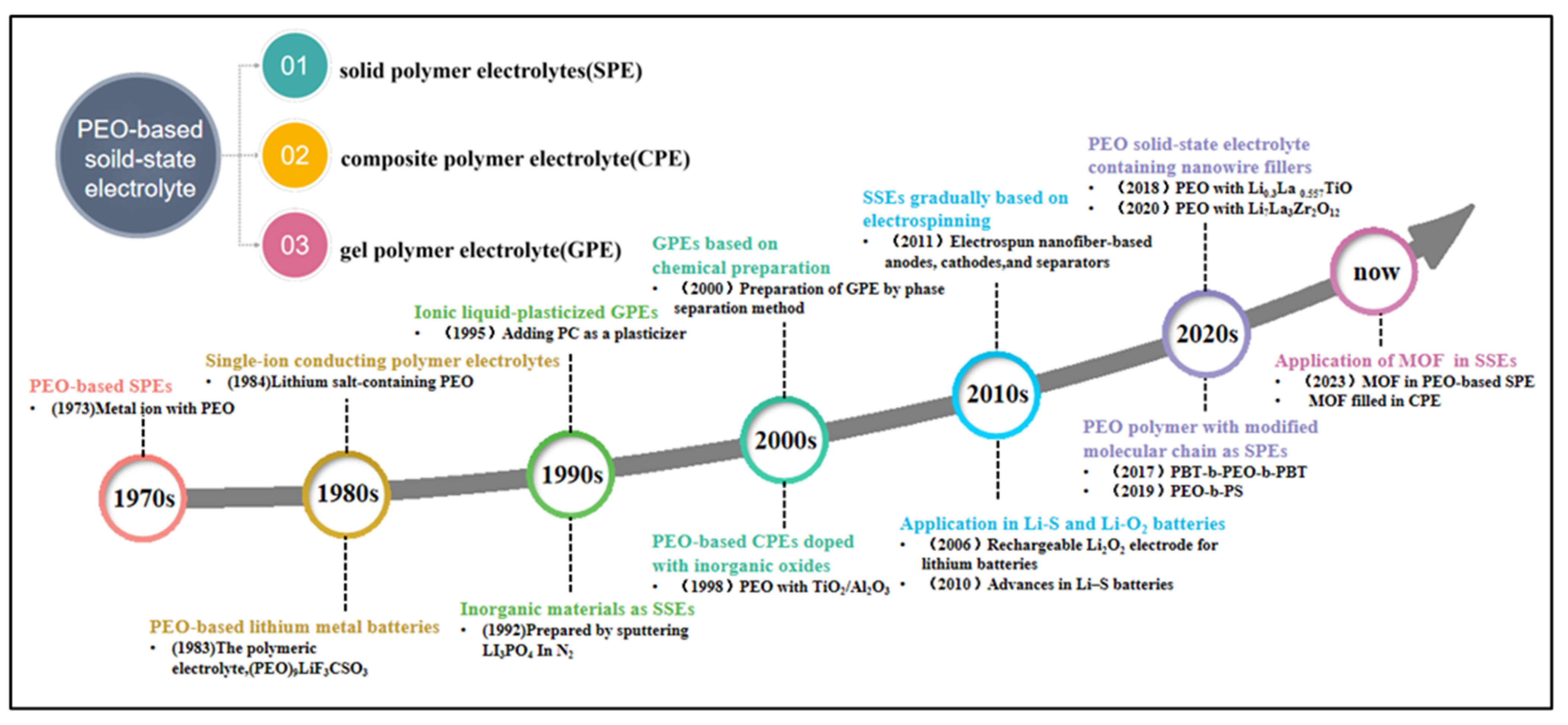

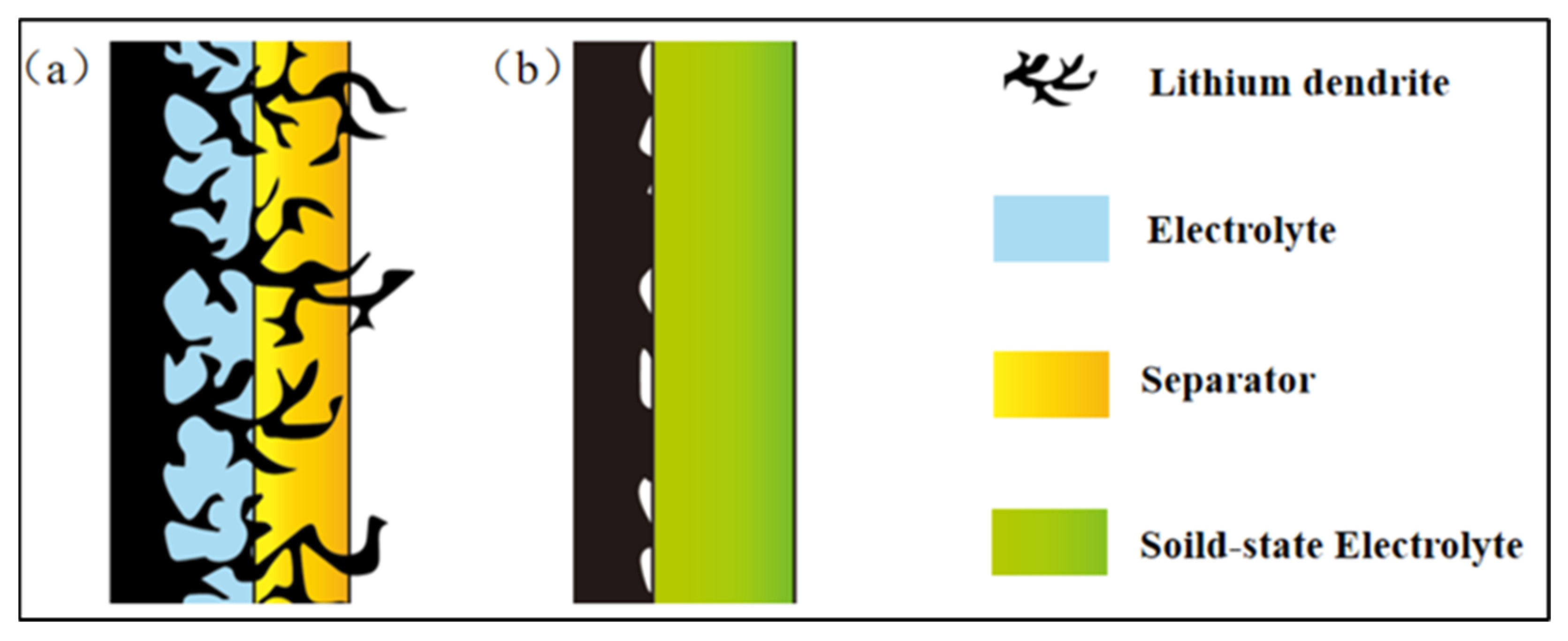



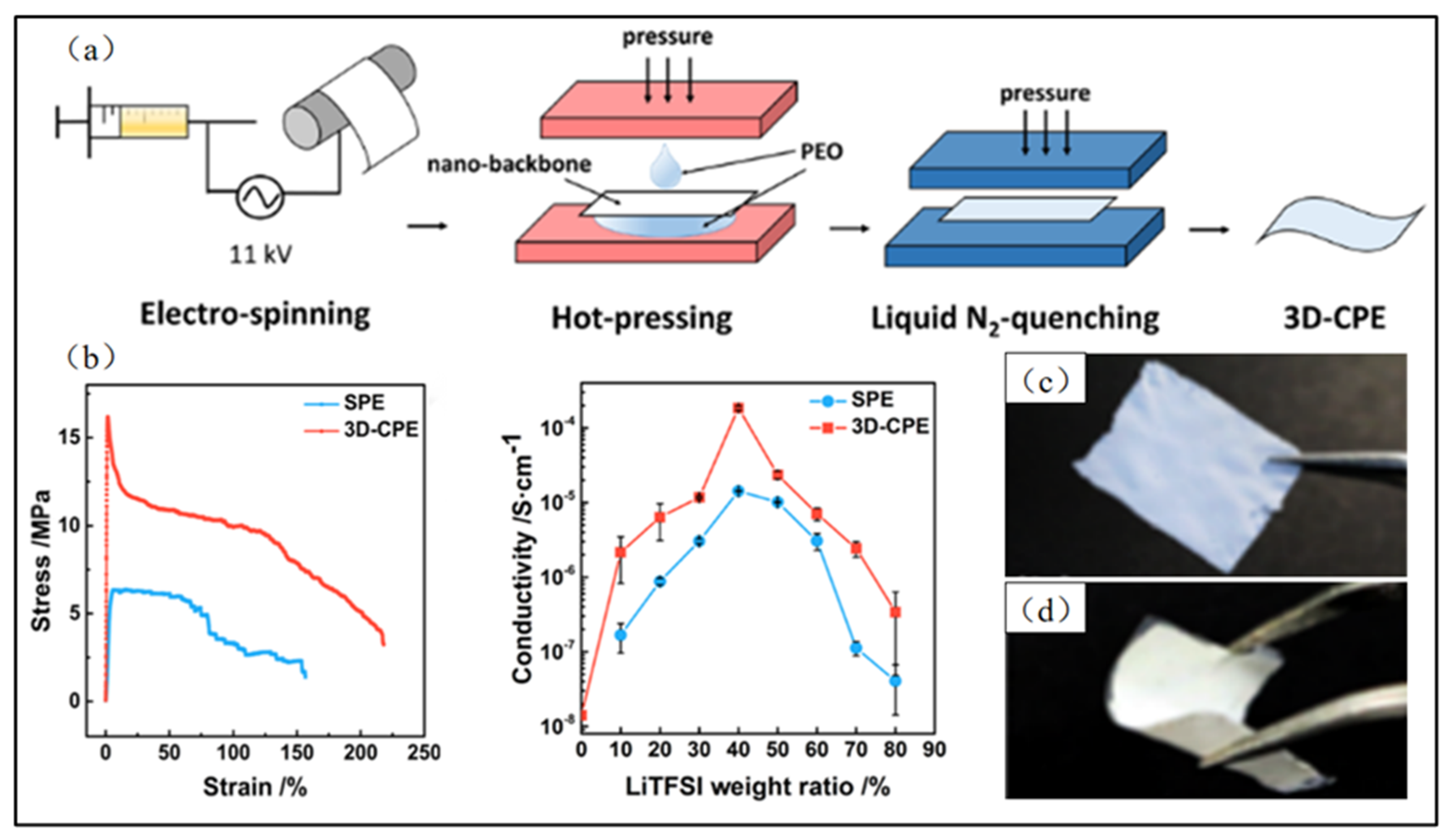

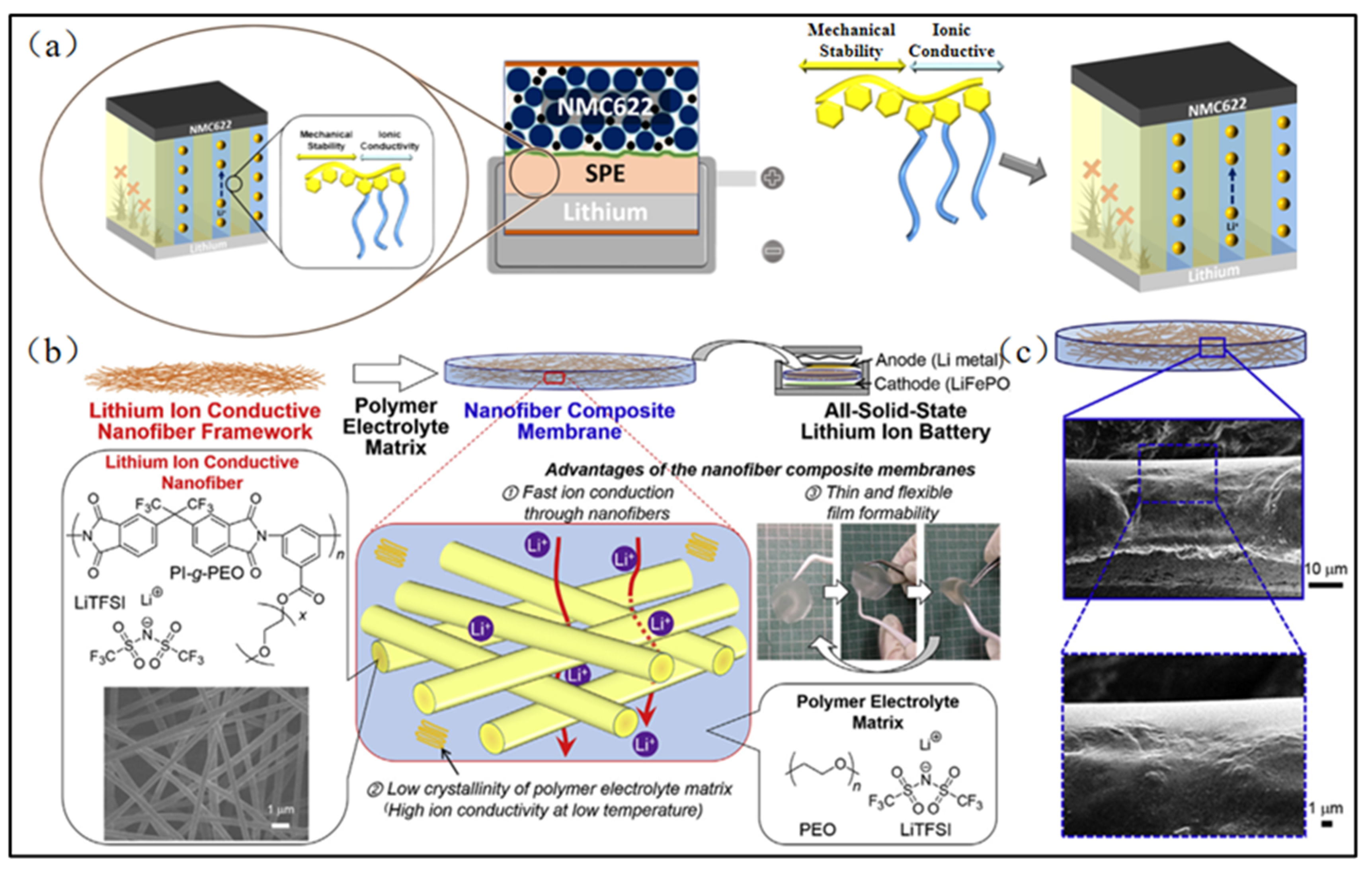
| Material | Avg. Fiber Diameter (μm) | Ionic Conductivity (S/cm) | Tensile Strength (MPa) | References |
|---|---|---|---|---|
| PEO SiO2 | 0.42 ± 0.08 | - | 1.7 | [85] |
| PEO SnO2 | 0.37 ± 0.06 | - | 1.4 | [85] |
| SiO2 LiClO4 PEO EC | 0.99 ± 0.27 | 8.7 × 10−5 | - | [86] |
| Al2O3 LiClO4 PEO EC | 0.47 ± 0.11 | 5.9 × 10−5 | - | [86] |
| LiClO4 PEO EC | 0.83 ± 0.45 | 1.6 × 10−5 | - | [86] |
| TiO2 LiClO4 PEO EC | 0.936 | 8.5 × 10−5 | 0.2 | [97] |
| SiO2 LiClO4 PEO | - | 4.8 × 10−5 | 2.03 | [98] |
| SiO2 LiFTSI PEO | - | 1 × 10−4(30 °C) | 3.1 | [99] |
| PAN PEO GO LiI PC DEC | 0.147 ± 0.023 | 1 × 10−2 | - | [90] |
| SiO2 LiClO4 PEO MWCNT EC | - | 2.1 × 10−4 | - | [92] |
| AgNWs@SiO2 PVDF-HFP PEO LiFTSI | - | 3.84 × 10−5(50 °C) | 10.23 | [93] |
| TiO2 LiClO4 PEO EC | 0.56 ± 0.15 | 4.5 × 10−5 | 0.2 | [89] |
| ZnO LiClO4 PEO EC | 0.73 ± 0.22 | 3.5 × 10−5 | 0.1 | [89] |
| Keggin-type hetero polyoxometalate LiClO4 PEO EC | 0.607 ± 0.19 | 2.8 × 10−4 | 0.15 | [100] |
| LLTO PEO LiFTSI | - | 5.53 × 10−5 | - | [94] |
| LLTO PEO LiFTSI | - | 1.84 × 10−4 | 16.18 | [95] |
| LLZAO PEO LiFTSI | - | 9.87 × 10−5(30 °C) | - | [96] |
| LLTO PEO PVDF LiFTSI | 0.088 | 6.02 × 10−5(50 °C) | 6 | [101] |
Disclaimer/Publisher’s Note: The statements, opinions and data contained in all publications are solely those of the individual author(s) and contributor(s) and not of MDPI and/or the editor(s). MDPI and/or the editor(s) disclaim responsibility for any injury to people or property resulting from any ideas, methods, instructions or products referred to in the content. |
© 2023 by the authors. Licensee MDPI, Basel, Switzerland. This article is an open access article distributed under the terms and conditions of the Creative Commons Attribution (CC BY) license (https://creativecommons.org/licenses/by/4.0/).
Share and Cite
Li, X.; Deng, Y.; Li, K.; Yang, Z.; Hu, X.; Liu, Y.; Zhang, Z. Advancements in Performance Optimization of Electrospun Polyethylene Oxide-Based Solid-State Electrolytes for Lithium-Ion Batteries. Polymers 2023, 15, 3727. https://doi.org/10.3390/polym15183727
Li X, Deng Y, Li K, Yang Z, Hu X, Liu Y, Zhang Z. Advancements in Performance Optimization of Electrospun Polyethylene Oxide-Based Solid-State Electrolytes for Lithium-Ion Batteries. Polymers. 2023; 15(18):3727. https://doi.org/10.3390/polym15183727
Chicago/Turabian StyleLi, Xiuhong, Yichen Deng, Kai Li, Zhiyong Yang, Xinyu Hu, Yong Liu, and Zheng Zhang. 2023. "Advancements in Performance Optimization of Electrospun Polyethylene Oxide-Based Solid-State Electrolytes for Lithium-Ion Batteries" Polymers 15, no. 18: 3727. https://doi.org/10.3390/polym15183727





